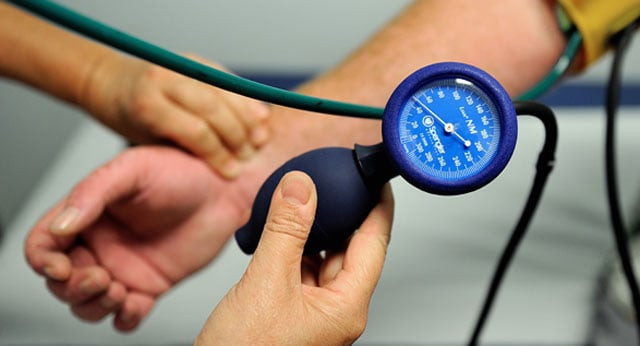Aggressive blood pressure control could help millions: study
Current guidelines urge adults to keep their blood pressure below 140 mm Hg

PHOTO: AFP
Patients who lowered their systolic number, meaning the higher of the two figures used to express blood pressure, to less than 120 mm Hg saw their risk of heart attack, heart failure or stroke drop by 24 percent, and their risk of death plummeted by 27 percent.
Current guidelines urge adults to keep their blood pressure below 140 mm Hg.
Top 10 causes of high blood pressure
In September, the National Institutes of Health-sponsored study was stopped a year early due to the positive results. On Monday, a detailed report on its findings was published in the New England Journal of Medicine.
"The positive results of this trial have taken most investigators by surprise, and the strong benefits of treatment seem to outweigh the risks," said co-author Alfred Cheung, chief of nephrology and hypertension at University of Utah Health Care.
7 foods to battle high blood presure
However, more research is needed before health authorities can recommend a change to current guidelines.
"Before deciding to treat blood pressure aggressively, it may be prudent to wait until additional questions are answered," Cheung added.
The treatment, which involves using medications to lower blood pressure along with healthy lifestyle choices, also came with an increased risk for some serious side effects, including blood pressure that fell too low, fainting, and kidney problems.
Researchers are also still investigating how the treatment might affect cognition, dementia and kidney disease.
The study involved more than 9,300 people who were randomly assigned to a blood pressure target of either 120 mm Hg or 140 mm Hg.
All the study participants were aged 50 or older and had faced an increased risk of cardiovascular disease, having a systolic blood pressure of at least 130 mmHg.
Cat naps at office can lower blood pressure
They also had no history of diabetes or stroke, a requirement which made the study population majority white, and tended to exclude many African Americans and Hispanics.
About 16.8 million people in the United States would fit the study and criteria and therefore might benefit from the approach, researchers said.
"Given that millions of US adults meet SPRINT eligibility criteria, the implementation of SPRINT recommendations could have a profound impact on how blood pressure is treated in this country," said senior author Paul Muntner, a professor of epidemiology at the University of Alabama.
"Even more important, is its potential for greatly reducing the incidence of cardiovascular disease."
More than one billion people worldwide have hypertension, which is defined as a systolic blood pressure of 140 or more, over a diastolic blood pressure of 90 or higher.



















COMMENTS
Comments are moderated and generally will be posted if they are on-topic and not abusive.
For more information, please see our Comments FAQ